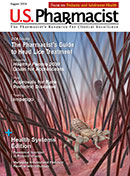The bacterium, which can cause dyspepsia, peptic ulcer disease, and gastric cancer, infects more than one-half the people in the world—although most are asymptomatic. The report in the American Journal of Gastroenterology noted that while its prevalence in North America is decreasing, H pylori still infects 30% to 40% of the population.
The previous guideline published in 2017 had maintained the recommendation of a PPI-clarithromycin triple therapy as the primary treatment option. In the new guideline, the number one recommendation for treatment-naïve patients is bismuth quadruple therapy.
Guideline authors explained that the treatment typically includes a PPI, tetracycline, bismuth, and a nitroimidazole for 14 days.
“We were already recommending that healthcare providers move away from PPI triple therapy in 2017 because of increasing problems with chloromycetin resistance amongst H pylori strains in the United States,” said corresponding author on the guideline William D. Chey, MD, chief of the Division of Gastroenterology and Hepatology at Michigan.
“Despite that recommendation, PPI triple therapy still dominates first-line therapy prescriptions for H pylori patients in the United States. In this newest iteration of the guideline, we are very clear to say that in essentially all circumstances you should not be prescribing PPI triple therapy, and you should be instead using bismuth quadruple therapy or one of the other suggested treatment options,” Dr. Chey added.
The guidelines call for treatment-naive patients with H pylori infection to receive the bismuth quadruple therapy (BQT) for 14 days as the preferred regimen when antibiotic susceptibility is unknown. The guideline authors suggested that rifabutin triple therapy or potassium-competitive acid blocker dual therapy for 14 days is a suitable empiric alternative in patients without penicillin allergy.
In treatment-experienced patients with persistent H pylori infection, the recommendation is for “optimized” BQT for 14 days for those who have not been treated with optimized BQT previously and for whom antibiotic susceptibility is unknown.
In patients previously treated with optimized BQT, rifabutin triple therapy for 14 days is “a suitable empiric alternative. Salvage regimens containing clarithromycin or levofloxacin should only be used if antibiotic susceptibility is confirmed,” according to the document.
The practice guidelines also addressed who to test, the need for universal posttreatment test-of-cure, and the current evidence regarding antibiotic susceptibility testing and its role in guiding the choice of initial and salvage treatment.
Overall, the guideline makes 12 total treatment suggestions for patients in a variety of different situations. The number two recommendation for treatment-naïve patients—after bismuth quadruple therapy—is rifabutin triple therapy (a PPI, rifabutin, and amoxicillin). A third option consists of a new, highly potent drug vonoprazan—which blocks stomach acid production—combined with the antibiotic amoxicillin.
The guidelines authors explained that the changes from previous recommendations were mostly motivated by important new data from North America including:
• Rising rates of resistance to key antibiotics used to treat H pylori, including clarithromycin and levofloxacin. This has led to reduced effectiveness of commonly used treatment regimens that contain these antibiotics
• Studies that have been conducted with novel treatment regimens featuring new antibiotic options (i.e., rifabutin) or more potent, next-generation gastric acid–suppressing agents (i.e., potassium-competitive acid blockers) in treatment-naïve individuals.
Another change in recommendations from the 2017 guideline is the discussion of increasingly available molecular testing for antibiotic susceptibility.
“Molecular testing really opens the door to the possibility of more liberally utilizing antibiotic sensitivity testing as a mechanism of tailoring therapy to the antibiotics that H pylori or a person infected with H pylori is sensitive to,” Dr. Chey said in a press release.
The content contained in this article is for informational purposes only. The content is not intended to be a substitute for professional advice. Reliance on any information provided in this article is solely at your own risk.






